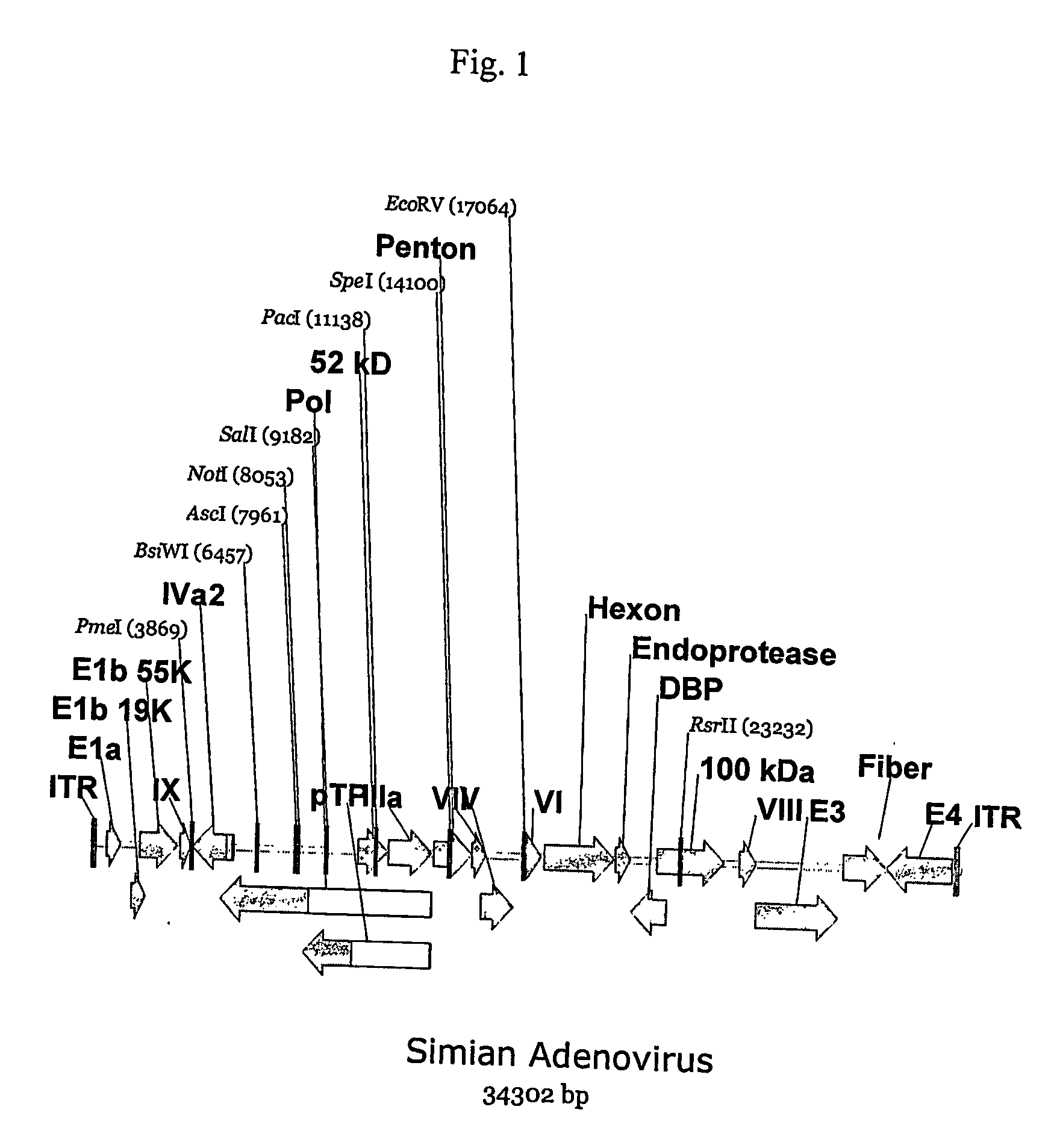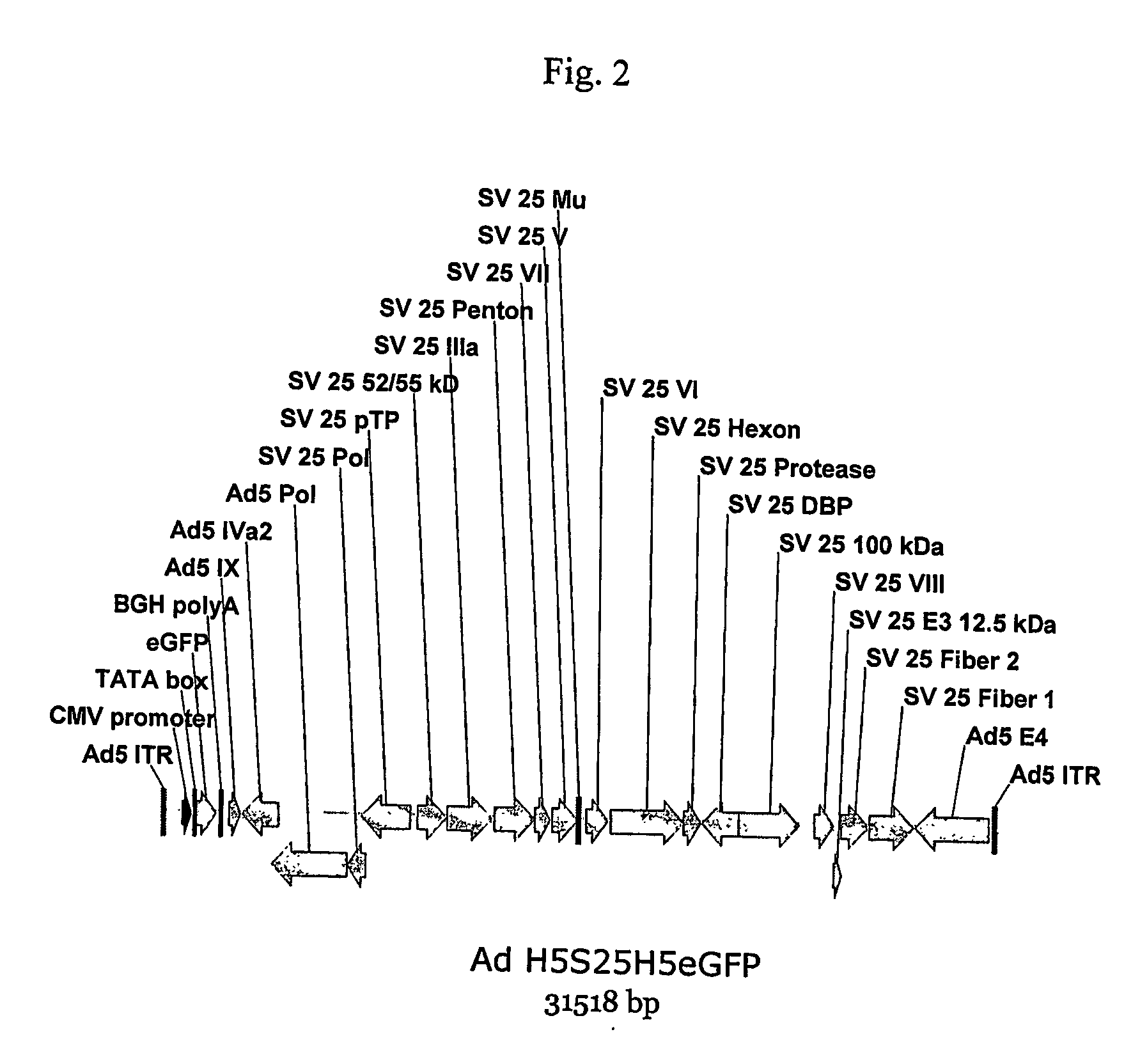Methods of generating chimeric adenoviruses and uses for such chimeric aden oviruses
a technology of chimeric adenoviruses and generating methods, which is applied in the direction of immunodeficiency, drug composition, peptides, etc., can solve the problems of limiting the effectiveness of gene therapy vectors based on serotypes, largely unsuccessful, and lack of a practical way to produce large numbers of such vectors
- Summary
- Abstract
- Description
- Claims
- Application Information
AI Technical Summary
Benefits of technology
Problems solved by technology
Method used
Image
Examples
example 1
Construction of Pan5 / C1 Chimeric Simian Viruses
[0164] Five different adenoviruses initially isolated from the chimpanzee, AdC68 [U.S. Pat. No. 6,083,716], AdPan5, AdPan7, AdPan6 and AdC1 [U.S. Pat. No. 6,083,716] have been sequenced. See, International Application No. PCT / US02 / 33645, filed November 2002 for the sequences of Pan5 [SEQ ID NO: 1], Pan7 [SEQ ID NO:3], and Pan6 [SEQ ID NO:2]. This application also provides sequences for SV1, SV25 and SV39 [SEQ ID No. 4, 5, 6, respectively]. Sequence comparison of the capsid protein sequences predicted that AdC1 clearly belonged to a different serological subgroup than the other four chimpanzee derived adenoviruses.
[0165] However, attempts to cultivate AdC1 in HEK293 cells revealed it to be fastidious in its growth characteristics (data not shown) and therefore possibly unsuitable for use as a vector using the currently available E1 complementing cell lines. However, because of the obvious sequence dissimilarity of AdC1 capsid protein s...
example 2
Construction of Ad5 Chimeric Simian Viruses
[0177] Plasmids have been constructed where the structural proteins derive from the chimpanzee adenovirus Pan 7 and the flanking sequences are derived from human Ad5 (the commonly used vector strain). The Adhu5-Pan7 chimeric adenovirus has been rescued, demonstrating that the chimeric virus construction method used to derive the chimeric virus is broadly applicable.
[0178] A. Construction of the Ad5-Pan 7 Chimeric Adenovirus
[0179] A plasmid was constructed which harbors the complete (E1 deleted) chimeric genome in order to establish that the chimeric adenovirus is viable, and then transfected the plasmid into the E1 complementing cell line HEK 293. It was found that the recombinant virus could be rescued. The chimeric adenovirus genome that was constructed is composed of a left end segment derived from Ad5 that contributes the ITR, the E1 deletion region containing the transgene expression cassette, the pIX and IVa2 genes and 954 C-termin...
example 3
Pan5—C1 Chimeric Vector of Invention as a Delivery Vehicle for Immunogenic Compositions
[0187] A Pan 5 (Simian adenovirus 22, a subgroup E adenovirus, also termed C5) —C1 (Simian adenovirus 21, a subgroup B adenovirus) chimeric expressing the Ebola virus (Zaire) glycoprotein (C5C1C5-CMVGP) was constructed as a model antigen in order to test the efficacy of the vector C5C1C5-CMVGP as a vaccine; this vector has been compared it to the Adhu5 based vector (H5-CMVGP). Compared to H5-CMVGP, the C5C1-CMVGP vector yielded only a slightly decreased level of GP expression in transduced A549 cells.
[0188] Thereafter, GP-specific T cell and B cell responses elicited in B10BR mice vaccinated intramuscularly with either 5×1010 H5-CMVGP or C5C1-CMVGP vectors were compared.
[0189] The C5C1C5-CMVGP vector appeared to induce lower frequencies of gamma interferon producing CD8+ T cells with kinetics slower than the H5-CMVGP vector as determined by intracellular cytokine staining using a H-2k restricte...
PUM
| Property | Measurement | Unit |
|---|---|---|
| weight | aaaaa | aaaaa |
| nucleic acid sequence | aaaaa | aaaaa |
| physiologically compatible | aaaaa | aaaaa |
Abstract
Description
Claims
Application Information
 Login to View More
Login to View More - R&D
- Intellectual Property
- Life Sciences
- Materials
- Tech Scout
- Unparalleled Data Quality
- Higher Quality Content
- 60% Fewer Hallucinations
Browse by: Latest US Patents, China's latest patents, Technical Efficacy Thesaurus, Application Domain, Technology Topic, Popular Technical Reports.
© 2025 PatSnap. All rights reserved.Legal|Privacy policy|Modern Slavery Act Transparency Statement|Sitemap|About US| Contact US: help@patsnap.com


